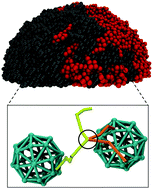Modeling individual and pairs of adsorbed polymer-grafted nanoparticles: structure and entanglements†
Abstract
We analyze the canopy structure and entanglement network of isolated polymer-grafted nanoparticles (PGNs) adsorbed on a surface. As expected, increasing the monomer–surface adsorption strength causes the polymer chains to spread out to increase contact with the surface, leading to a canopy shape that is in qualitative agreement with recent experimental results. We compare height profiles and other structural features of four PGN systems to show the separate and combined effects of increasing chain length and graft density. At moderate graft density and low surface attraction strength, nearby PGN canopies interpenetrate substantially and their combined shape is similar to that of a single PGN canopy. At high graft density or surface interaction, the interparticle spacing increases significantly. We use a geometrical primitive path analysis to calculate average entanglement properties including canopy–canopy entanglements between pairs of PGNs. The longer chain systems are well entangled at both graft densities considered, and we find that as the monomer–surface interaction strength is increased (and the interparticle distance increases), entanglements between the two PGNs are reduced. We find that the number of inter-PGN entanglements per chain is slightly larger at the lower graft density, likely because steric constraints at high graft density tend to reduce interparticle entanglements.



 Please wait while we load your content...
Please wait while we load your content...